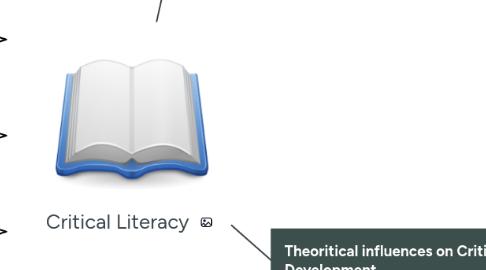
1. Origins of Critical Literacy
1.1. Critical theory proposed by Paulo Freire Educational Program for Adult workers, Consists of 3 concepts
1.1.1. 1. Critical Consiousness of a learners
1.1.2. 2. Students and teachers participation in dialogic discourse
1.1.3. 3. recognize students' prior knowledge
2. Theoritical influences on Critical Literacy Development
2.1. Implications for Classrooms
2.1.1. Classroom practice by Freebody andLuke(1990), the revised model, guideforcrititical readers and writers: Break thecode of texts, participate in the meaning oftext, use text functionally and criticallyanalyze and transform texts
2.1.2. Lanksher and Knobel (2004) proposeddigital technologies, emphasize textproduction rather than text analysis
2.1.3. Janks (2000,2009): domination, access, diversity, and design
2.1.4. Rodgers and Wetzel (2013): three dominant tradition within critical literacy includes genre approach, multiple literacy approach, social justice approach
2.2. Implications for Literacy Research
2.2.1. Recontextualization (Dyson, 2013)
2.2.2. Comber(2003,2013) ctitical literacy principles: engaging with local realities, researching and analyzing language power relationship, practice and effects, mobilixing students' knowledge and practice, redesigning text, suberting taken for granted school texts, focusing on students' use of local contexts and examining how power is exercised and by whom
2.2.3. Classroom Case study:NegotiatingCriticalLiteracies Withyoung Children(Vasquez,2014)
2.2.3.1. 1.Context:Multiethnic,middleclasscommunity,half daypreschoolclass. 2. Physical EnvironmentandResources:Opem area for class meeting,artarea, andlibrary 3.Curriculum:Incorporatedpostmodernistand feministtheory, use audit trail as acentral aspect ofpedagogy.MandatedCurricula and focus onskills 4. Practice: Using Daily class meeting
2.2.3.2. Analysis and Results:1. Children are able to lead and use theresources for their interests2. Children felt a strong sense of agency to identify the discursive practice so they acthieve their goals 3. Children can use specific literacy skills; writing letter language to affect social change
2.2.3.3. Reflections: 1. Three principles of developing criticalliteracy pedagaogy: repositioning studentsas researcher of language, respectingminority language practice andproblematizing texts are included and usedin Case study 2. The development of critical pedagogy and curriculum changes the classroom dynamics, conversations among learners and teachers, students' orientation to knowledge and texts 3. Critically examine the way in which teachers and their students are represented 4. Adverstising everyday texts across variety of media 5. Critical approach to curriculum design must be wider to social issues 6.use contrstruction of texts and communication practices

